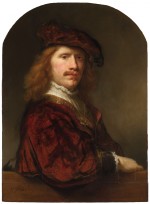The Amsterdam house Rembrandt once owned, now a charming museum, is the start of a a few wonderful temporary exhibition. Most people are unaware Rembrandt generated a large part of his income by teaching. Many successful 17th century painters were his students.
 Rembrandt did not teach beginning painters. He does seem to have taught the occasional amateur. His niche however, were painters who had already studied with other teachers. Like Rembrandt himself, his students had had their basic training elsewhere. They traveled to Amsterdam to acquire a kind of ‘finishing touch’ by studying with the Dutch Republic’s latest and greatest masters.
Rembrandt did not teach beginning painters. He does seem to have taught the occasional amateur. His niche however, were painters who had already studied with other teachers. Like Rembrandt himself, his students had had their basic training elsewhere. They traveled to Amsterdam to acquire a kind of ‘finishing touch’ by studying with the Dutch Republic’s latest and greatest masters.
Rembrandt’s most successful students were Ferdinand Bol and Govert Flinck. Where Rembrandt went from riches to rags, they went from not fairly well-off to richer and richer. At least three Amsterdam exhibitions currently focus on these two students, their paintings, lives, and the reasons they became so successful.
Interested in the story, the painters, their works and lives? Best to start with a visit to Rembrandt’s former home; now the Rembrandt House Museum. Here, the exhibition concentrates on the time Bol and Flinck were two of Rembrandt’s many students.

Ferdinand Bol: Rembrandt
Two floors show works by Rembrandt and his two students. It is easy to see the students started by copying the master. Same theme, same scenes; styles which are difficult to distinguish.
Yet there are differences. In one painting, an angel faces visitors while in the student’s version the angel is flying away from them. It seems that on some drawings, Rembrandt’s corrections or improvements can be detected in quick, broad strokes. He must have been a stern master. For those interested, like Bol and Flinck, Rembrandt also taught etching.
The small exhibition ends when both contemporaries and students striking out on their own. Once they are free and independent painters, their styles will slowly alter. They will not just start competing against each other for customers. By carefully using their networks, they will beat Rembrandt for the most lucrative projects.

Govert Flinck: self-portrait
One will be asked to paint scenes for the new townhouse, at the Dam Square. When he dies, Rembrandt is asked to take over the commission. He will paint his “The conspiracy of Claudius Civilis”; which will be rejected.
Rembrandt’s other student will do even better. He will become rich enough to stop working. Instead, he will rent a beautiful canal house and continue adding to his collection of contemporary paintings.
Where the exhibition at the Rembrandthuis Museum concentrates on the time Bol and Flinck were Rembrandt’s students, the two other exhibitions take up their stories after they have become independent, successful artists. The exhibition at the Rembrandt House Museum will terminate 18th February 2018
Museum Rembrandthuis, exhibition ‘Rembrandt’s most successful students I
